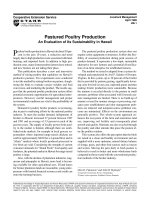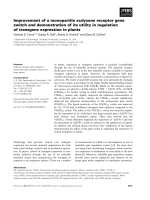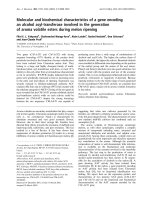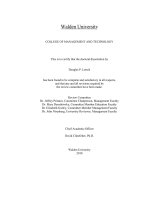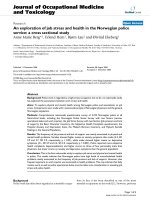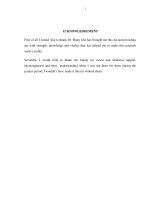The ancient gene c12orf29 an exploration of its role in the chordate body plan
Bạn đang xem bản rút gọn của tài liệu. Xem và tải ngay bản đầy đủ của tài liệu tại đây (15.42 MB, 397 trang )
THE ANCIENT GENE C12ORF29:
AN EXPLORATION OF ITS ROLE IN THE
CHORDATE BODY PLAN
Thor Einar Friis
Bachelor of Science (Hons)
Submitted in fulfilment of the requirements for the degree of
Doctor of Philosophy
Institute of Health and Biomedical Innovation
Faculty of Built Environment and Engineering
Queensland University of Technology
January 2013
Keywords
Complementary DNA library
Evolutionary biology
Developmental biology
Skeletal development
Cartilage
Phylogeny
Chordate body plan
The Ancient Gene C12orf29: An Exploration of its Role in the Chordate Body Plan
i
ii
The Ancient Gene C12orf29: An Exploration of its Role in the Chordate Body Plan
Abstract
The sheep (Ovis aries) is commonly used as a large animal model in skeletal research. Although the sheep genome has been sequenced there are still only a limited
number of annotated mRNA sequences in public databases. A complementary DNA
(cDNA) library was constructed to provide a generic resource for further exploration
of genes that are actively expressed in bone cells in sheep. It was anticipated that the
cDNA library would provide molecular tools for further research into the process of
fracture repair and bone homeostasis, and add to the existing body of knowledge.
One of the hallmarks of cDNA libraries has been the identification of novel genes
and in this library the full open reading frame of the gene C12orf29 was cloned and
characterised. This gene codes for a protein of unknown function with a molecular
weight of 37 kDa. A literature search showed that no previous studies had been conducted into the biological role of C12orf29, except for some bioinformatics studies
that suggested a possible link with cancer. Phylogenetic analyses revealed that
C12orf29 had an ancient pedigree with a homologous gene found in some bacterial
taxa. This implied that the gene was present in the last common eukaryotic ancestor,
thought to have existed more than 2 billion years ago. This notion was further supported by the fact that the gene is found in taxa belonging to the two major eukaryotic branches, bikonts and unikonts. In the bikont supergroup a C12orf29-like
gene was found in the single celled protist Naegleria gruberi, whereas in the unikont
supergroup, encompassing the metazoa, the gene is universal to all chordate and,
therefore, vertebrate species. It appears to have been lost to the majority of cnidaria
and protostomes taxa; however, C12orf29-like genes have been found in the cnidarian freshwater hydra and the protostome Pacific oyster. The experimental data
indicate that C12orf29 has a structural role in skeletal development and tissue homeostasis, whereas in silico analysis of the human C12orf29 promoter region suggests that its expression is potentially under the control of the NOTCH, WNT and
TGF- developmental pathways, as well SOX9 and BAPX1; pathways that are all
heavily involved in skeletogenesis. Taken together, this investigation provides strong
evidence that C12orf29 has a very important role in the chordate body plan, in early
skeletal development, cartilage homeostasis, and also a possible link with spina bifida in humans.
The Ancient Gene C12orf29: An Exploration of its Role in the Chordate Body Plan
iii
iv
The Ancient Gene C12orf29: An Exploration of its Role in the Chordate Body Plan
Table of Contents
Keywords .................................................................................................................................................. i
Abstract .................................................................................................................................................. iii
Table of Contents .................................................................................................................................... v
List of Figures ....................................................................................................................................... viii
List of Tables .......................................................................................................................................... xii
List of Abbreviations ............................................................................................................................. xiii
Statement of Original Authorship ....................................................................................................... xxii
Acknowledgements ............................................................................................................................ xxiii
CHAPTER 1: INTRODUCTION ...................................................................................................... 1
1.1
Background .................................................................................................................................. 1
1.2
Context ......................................................................................................................................... 2
1.3
Purposes ....................................................................................................................................... 3
1.4
Thesis Outline .............................................................................................................................. 4
CHAPTER 2: LITERATURE REVIEW .............................................................................................. 7
2.1
A brief introduction to skeletal biology ....................................................................................... 7
2.2
Complementary DNA libraries and their utility in biological research...................................... 32
2.3
The sheep as an animal model ................................................................................................... 35
2.4
Summary and Implications ........................................................................................................ 37
CHAPTER 3: METHODS AND MATERIALS .................................................................................. 41
3.1
Methodology and Research Design ........................................................................................... 41
3.1.1 Introduction .................................................................................................................... 41
3.2
Construction of a cDNA library to identify genes expressed in cells derived from sheep bone 44
3.2.1 Cell culture ...................................................................................................................... 44
3.2.2 RNA extraction ................................................................................................................ 45
3.2.3 cDNA library construction ............................................................................................... 47
3.2.4 PCR based methods for isolating full length cDNA clones .............................................. 53
The Ancient Gene C12orf29: An Exploration of its Role in the Chordate Body Plan
v
3.2.5 Library Screening: Method for amplification and isolation of cDNA from plasmid
libraries that require no hybridization (MACH) .............................................................. 53
3.2.6 Validation of cDNA library .............................................................................................. 57
3.3
C12orf29 – Characterization of a protein of unknown fuction .................................................. 59
3.3.1 Subcloning C12orf29 cDNA into an epitope tagged expression vector .......................... 60
3.3.2 Validation of C12orf29 antibody specificity by western blot (WB) analysis ................... 75
3.3.3 Immunofluorescent (IF) microscopy ............................................................................... 83
3.3.4 Immunohistochemistry (IHC) .......................................................................................... 85
3.3.5 RT‐qPCR analysis of C12orf29 expression in sheep primary cells ................................... 88
3.3.6 WB analysis of C12orf29 protein expression in sheep primary cells .............................. 90
3.4
Bioinformatics analyses of C12orf29 ......................................................................................... 91
3.4.1 Phylogenetic analyses ..................................................................................................... 91
3.4.2 Molecular genetics analyses ........................................................................................... 94
CHAPTER 4: RESULTS .............................................................................................................. 99
4.1
Results – Introduction ................................................................................................................ 99
4.2
cDNA library construction ........................................................................................................ 100
4.2.1 Isolation of GAPDH cDNA clone using the MACH protocol .......................................... 107
4.2.2 Validation of the cDNA library ...................................................................................... 111
4.3
C12orf29 – Experimental Results ............................................................................................. 117
4.3.1 Subcloning and epitope tagging the C12orf29 cDNA clone .......................................... 117
4.3.2 Validating the specificity of the anti‐C12orf29 antibodies ........................................... 119
4.3.3 Immunofluorescent microscopy ................................................................................... 125
4.3.4 Immunohistochemistry ................................................................................................ 130
4.3.5 Real time quantitative PCR analysis ............................................................................. 145
4.3.6 WB analysis of C12orf29 protein expression in sheep primary cells ............................ 147
4.4
C12orf29 – Bioinformatics analyses ......................................................................................... 149
4.4.1 Phylogenetic analyses ................................................................................................... 149
4.4.2 Molecular genetics analyses ......................................................................................... 156
CHAPTER 5: ANALYSIS AND DISCUSSION ............................................................................... 173
5.1
vi
Introduction ............................................................................................................................. 173
The Ancient Gene C12orf29: An Exploration of its Role in the Chordate Body Plan
5.2
The cDNA libary – Analysis and discussion .............................................................................. 174
5.2.1 A brief review of some of the genes isolated from the cDNA library ........................... 176
5.2.2 cDNA library construction – Conclusions ...................................................................... 200
5.3
Experimental characterization of C12orf29 – Analysis and Discussion ................................... 206
5.3.1 Molecular cloning experiments .................................................................................... 206
5.3.2 Validation of the commercial C12orf29 antibodies ...................................................... 207
5.3.3 Immunofluorescent microscopy – Discussion .............................................................. 211
5.3.4 Immunohistochemistry – Discussion ............................................................................ 212
5.3.5 RT‐qPCR and western blot analysis – Discussion .......................................................... 217
5.4
Discussion – C12orf29 phylogenetic analyses .......................................................................... 219
5.4.1 Distribution of C12orf29‐like proteins in eukaryata ..................................................... 221
5.4.2 C12orf29 and the chordate superphylum .................................................................... 226
5.4.3 Vertebrates – The Craniata ........................................................................................... 234
5.4.4 Conclusions – Tracing C12orf29 through biological time and space ............................ 236
5.5
Discussion – Promoter Analysis ............................................................................................... 242
CHAPTER 6: CONCLUSIONS AND FUTURE WORK .................................................................... 247
6.1
Conclusions and future work – Introduction ........................................................................... 248
6.1.1 The ancient gene C12orf29 – Putting together the pieces of the puzzle ..................... 249
6.2
C12orf29: the working hypothesis – What does it do? ............................................................ 254
6.3
Future work .............................................................................................................................. 256
BIBLIOGRAPHY .......................................................................................................................... 261
APPENDICES .......................................................................................................................... 299
APPENDIX A – MICROBIOLOGY MATERIALS ........................................................................................ 300
APPENDIX B – METHODS ..................................................................................................................... 301
APPENDIX C – TRANSCRIPTS OF CDNA LIBRARY SEQUENCES SUBMITTED TO GENBANK ................... 323
APPENDIX D – ALL KNOWN C12ORF29 PROTEIN SEQUENCES (DEC 2012) ......................................... 356
APPENDIX E – STATISTICAL ANALYSIS ................................................................................................. 365
APPENDIX F – TRANSCRIPT FROM THE SCIENCE SHOW ON ABC RADIO NATIONAL ........................... 366
APPENDIX G – CONFERENCES AND PUBLICATIONS ............................................................................ 368
The Ancient Gene C12orf29: An Exploration of its Role in the Chordate Body Plan
vii
List of Figures
Figure 2‐1: Schematic cross‐section of the trunk of a vertebrate. .......................................................... 9
Figure 2‐2: The somite forms two main components: sclerotome and dermomyotome. .................... 10
Figure 2‐3: Ventral view of vertebral columns of Pax1 null and classical undulated
homozygous mice at the newborn stage. .................................................................... 15
Figure 2‐4: Roentgenography of cervical vertebrae of a 25 year old man with KFS. ............................ 17
Figure 2‐5: Schematic of the branchial arches and the development of the upper and lower
jaws. ..................................................................................................................................... 20
Figure 2‐6: Cells acquire their positional value in the progress zone that is specified at the
distal end of the bud by the apical ectodermal ridge. ......................................................... 21
Figure 2‐7: Establishing the DV axis of the limbs. ................................................................................. 23
Figure 2‐8: Models of PD limb axis development. ................................................................................ 25
Figure 2‐9 The BMP protein family. ..................................................................................................... 28
Figure 2‐10: The BMP signalling cascade. ............................................................................................. 30
Figure 2‐11: Constructing a cDNA library .............................................................................................. 34
Figure 2‐12: WNT/‐Catenin, FGF, NOTCH, Hedgehog, and TGF/BMP are the major pathways
regulating skeletal development. ......................................................................................... 37
Figure 3‐1: Effect of in vitro Dex treatment of human BMSCs. ............................................................. 42
Figure 3‐2: The sequence of the 50‐base oligonucleotide primer. ....................................................... 47
Figure 3‐3: MACH library screening protocol. ....................................................................................... 55
Figure 3‐4: The pcDNA3.1(+) expression vector.................................................................................... 62
Figure 3‐5: The pcDNA3.1‐HA vector was double digested with EcoRV/XhoI....................................... 63
Figure 3‐6: Pre‐ligation quality control. ................................................................................................ 64
Figure 3‐7: An analytical digest of the plasmid preps ........................................................................... 67
Figure 3‐8: Sequencing results of C12orf29 inserts. ............................................................................. 67
Figure 3‐9: Strategy to retrofit an HA sequence into pcDNA‐C12orf29. ............................................... 69
Figure 3‐10: Double digestion of the pcDNA3.1‐C12orf29 plasmid.. .................................................... 70
Figure 3‐11: Nanodrop quantification of annealed HA oliogonucleotides. .......................................... 71
Figure 3‐12: PCR analysis of colonies selected from plate #1 ............................................................... 73
Figure 3‐13: Analytical digest of colonies identified as potential carriers of the HA tag. ..................... 74
Figure 3‐14: WB analysis of C12orf29 expression with Abcam C12orf29 antibody. ............................. 76
Figure 3‐15: WB analysis of C12orf29 expression with Santa Cruz C12orf29 antibody. ....................... 77
Figure 3‐16: WB analysis of C12orf29 expression with Sigma C12orf29 antibody ............................... 78
Figure 3‐17: WB analysis of C12orf29 expression with Everest Biotech C12orf29 antibody. ............... 79
viii
The Ancient Gene C12orf29: An Exploration of its Role in the Chordate Body Plan
Figure 3‐18: In humans, the gene C12orf29 is located on the long arm of chromosome 12. ............... 94
Figure 3‐19: Defining the cis‐regulatory region for the human C12orf29 gene by phylogenetic
footprinting. ......................................................................................................................... 96
Figure 4‐1: Shows the effect osteogenic induction medium on cell morphology. .............................. 100
Figure 4‐2: Quantification of cDNA fractions on an ethidium bromide gel......................................... 102
Figure 4‐3: Pilot ligation and transformation. ..................................................................................... 103
Figure 4‐4: The analytical digests revealed the presence of inserts in all of the plasmids ................. 104
Figure 4‐5: Three cDNA clones were isolated using the MACH protocol. ........................................... 107
Figure 4‐6: The Ovis aries GAPDH protein sequence. ......................................................................... 108
Figure 4‐7: Very highly expressed genes in the cDNA library. ............................................................. 111
Figure 4‐8: Highly expressed genes in the cDNA library. .................................................................... 112
Figure 4‐9: Lowly expressed genes in the cDNA library. ..................................................................... 112
Figure 4‐10: Genes with the lowest expression in the cDNA library. .................................................. 113
Figure 4‐11: The relative expression of all the genes tested on a logarithmic scale. .......................... 113
Figure 4‐12: Effect of osteogenic induction medium on BMSCs, mOBs, and tOBs. ............................ 116
Figure 4‐13: DNA and protein sequence of the recombinant HA‐C12orf29 plasmids. ....................... 118
Figure 4‐14: Western blot experiment using the Licor double antibody labelling system. ................ 119
Figure 4‐15: The Abcam anti‐C12orf29 antibody detects the HA‐C12orf29 recombinant protein ..... 120
Figure 4‐16: Anti‐C12orf29 antibodies detect protein bands of the same molecular weight in
3T3‐E1 cell lysates. ............................................................................................................. 121
Figure 4‐17: Anti‐C12orf29 antibodies detect protein bands of the same molecular weight in
C‐28/12 cell lysates. ........................................................................................................... 122
Figure 4‐18: EB49 and Santa Cruz anti‐C12orf29 antibodies were tested on CHO cell lysates
overexpressing recombinant C12orf29. ............................................................................. 123
Figure 4‐19: The Abcam and EB49 anti‐C12orf29 antibodies were tested on 3T3‐E1 cell
lysates.. ............................................................................................................................... 124
Figure 4‐20: Murine 3T3‐E1 cells transfected with HA‐C12orf29 plasmid and probed with an
anti‐HA antibody. ............................................................................................................... 125
Figure 4‐21: Sheep mandible osteoblast cells labelled with Abcam anti‐C12orf29 antibody and
Phalloidin/DAPI.. ................................................................................................................ 126
Figure 4‐22: Sheep PDL cells labelled with Abcam anti‐C12orf29 antibody and Phalloidin/DAPI. ..... 127
Figure 4‐23: Sheep PDL cells. The C12orf29 protein appears to accumulate at the edges of
many of the cells (arrowheads). ......................................................................................... 128
Figure 4‐24: PC3 cells labelled with Abcam anti‐C12orf29 and Phalloidin/DAPI. ............................... 129
Figure 4‐25: Normal human full thickness articular cartilage. ............................................................ 131
Figure 4‐26: Osteoarthritic human articular cartilage. ....................................................................... 132
Figure 4‐27: Rat tibial head showing the growth plate and trabecular bone. .................................... 133
The Ancient Gene C12orf29: An Exploration of its Role in the Chordate Body Plan
ix
Figure 4‐28: Rat femoral head growth plate. ...................................................................................... 134
Figure 4‐29: Mouse embryo at 13.5 dpc. ............................................................................................ 136
Figure 4‐30: Human embryo sample at 7–8 weeks of gestation ........................................................ 137
Figure 4‐31: COL2 expression in the developing human axial skeleton. ............................................. 138
Figure 4‐32: C12orf29 expression in the developing axial skeleton of a human embryo at 7–8
weeks gestation using the Abcam C12orf29 antibody. ...................................................... 139
Figure 4‐33: C12orf29 expression in the developing axial skeleton of a human embryo at 7–8
weeks gestation using the EB49 C12orf29 antibody. ......................................................... 141
Figure 4‐34: SOX9 and BAPX1 expression in the developing human axial skeleton.. ......................... 143
Figure 4‐35: The melt curve analysis for the sheep C12orf29 primers ............................................... 145
Figure 4‐36: RT‐qPCR analysis showed there is clear effect of osteogenic induction medium on
the gene expression of C12orf29 ....................................................................................... 146
Figure 4‐37: WB analysis of cell lysates from sheep primary cells treated with osteogenic
induction medium. ............................................................................................................. 147
Figure 4‐38: Sequence alignment of human C12orf29 against orthologous proteins from the
basal species identified by BLASTP search. ........................................................................ 152
Figure 4‐39: Baysian phylogenetic reconstruction of C12orf29 using MrBayes. ................................ 154
Figure 4‐40: In primates there is a cryptic exon (exon 1a) within the first intron. ............................. 157
Figure 4‐41: The human C12orf29 gene has a distinct 500 bp CpG island.......................................... 160
Figure 4‐42: Schematic showing the structural organisation of an RNA polymerase II
promoter. ........................................................................................................................... 161
Figure 4‐43: C12orf29 promoter sites identified by the TFSitescan search. ....................................... 163
Figure 4‐44: Core promoter region of human C12orf29 showing a TATA box and binding sites
for Sp1, c‐MYC, CSL and HES‐1. .......................................................................................... 166
Figure 4‐45: SOX consensus binding sites in the promoter region of the human C12orf29 gene. ..... 168
Figure 4‐46: NKX3.2 consensus binding sites in the C12orf29 promoter region. ............................... 169
Figure 4‐47: TCF/LEF consensus DNA binding motifs in the C12orf29 promoter region. ................... 170
Figure 4‐48: The DNA sequence motif CAGA is essential and sufficient for the induction of
TGF‐ responsive genes. .................................................................................................... 171
Figure 5‐1: The first reports of cDNA cloning and libraries appeared in 1975. ................................... 174
Figure 5‐2: OPN and OCN mRNA expression is downregulated by 10‐7 M dexamethasone in
sheep osteoblasts. .............................................................................................................. 202
Figure 5‐3: An initial RT‐qPCR assay indicated that C12orf29 gene expression was upregulated
in response to osteogenic induction medium. ................................................................... 206
Figure 5‐4: Periodontal ligament cell stained with the Abcam C12orf29 antibody. ........................... 211
Figure 5‐5: C12orf29 expression in tibial head in the rat. ................................................................... 212
Figure 5‐6: Comparison of C12orf29 signal in the cranial vault of the forebrain in 13.5 dpc
mouse embryos. ................................................................................................................. 213
x
The Ancient Gene C12orf29: An Exploration of its Role in the Chordate Body Plan
Figure 5‐7: The H.chejuensis HCH_06039 protein contains a conserved domain with similarity
to the adenylation DNA ligase superfamily.. ...................................................................... 220
Figure 5‐8: The free‐living protist Nagleria’s predominant body form is amoeboid ........................... 221
Figure 5‐9: The freshwater Hydra is a member of the Cnidaria superphylum, class medusozoa. ...... 222
Figure 5‐10: The Pacific oyster Crassostera gigas. .............................................................................. 223
Figure 5‐11: Amino acid alignment of human C12orf29 against Pacific oyster C12orf29‐like
protein.. .............................................................................................................................. 224
Figure 5‐12: Molecular phylogenetic analysis of C12orf29 by ML method using MEGA5. ................. 225
Figure 5‐13: Schematic showing the principal common features of the Chordate superphylum. ..... 226
Figure 5‐14: A simplified phylogenetic tree showing the relationship between Bilateria and
Cnidaria. ............................................................................................................................. 227
Figure 5‐15: A juvenile acorn worm at day 13 of development. ......................................................... 228
Figure 5‐16: The acorn worm has two putative C12orf29 orthologs .................................................. 229
Figure 5‐17: Ciona intestinalis larva. ................................................................................................... 230
Figure 5‐18: The ascidian species C. intestinalis and C. savignyi each carry a copy of the
C12orf29 gene.. .................................................................................................................. 231
Figure 5‐19: The amphioxus Branchiostoma floridae ......................................................................... 232
Figure 5‐20: Phylogenetic relationships of extant chordates. ............................................................. 234
Figure 5‐21: A BLASTN search returned 138 lamprey contigs with sequence similarity to
human C12orf29. ................................................................................................................ 235
Figure 5‐22: Tracing C12orf29 through biological time and space. .................................................... 241
Figure 6‐1: Protein alignment comparing human C12orf29 protein with the zebrafish C12orf29
homolog. ............................................................................................................................ 256
Figure 6‐2: C12orf29 microsynteny between zebrafish and humans. ................................................ 257
Figure 6‐3: The promoter region of D. rerio C12orf29 gene. .............................................................. 258
The Ancient Gene C12orf29: An Exploration of its Role in the Chordate Body Plan
xi
List of Tables
Table 3‐1: M13 universal primer sequences. ........................................................................................ 51
Table 3‐2: MACH primer sequences for sheep GAPDH ......................................................................... 54
Table 3‐3: PCR cycling parameters used for the MACH isolation protocol. .......................................... 54
Table 3‐4: List of primers used for RT‐qPCR validation of cDNA library................................................ 58
Table 3‐5: The cloning primers used for subcloning C12orf29 into a pcDNA3.1(+) plasmid ................ 61
Table 3‐6: Two reactions were setup to amplify the C12orf29 ORF with the cloning primer. ............. 61
Table 3‐7: Touchdown temperature cycling conditions for C12orf29 PCR amplification. .................... 61
Table 3‐8: Primer sequence of retrofit HA tag. ..................................................................................... 68
Table 3‐9: Colony numbers from transformation with HA retrofitted plasmids. ................................. 72
Table 3‐10: Colony numbers following HindIII digest of HA retrofitted plasmids ................................. 73
Table 3‐11: DNA plasmid yields from colonies identified from analytical PCR reaction. ...................... 74
Table 3‐12: Reagent volumes for transfection for antibody specificity experiments. .......................... 80
Table 3‐13: Primary antibody solutions for WB analysis. ..................................................................... 82
Table 3‐14: List of primers used for RT‐qPCR of C12orf29 mRNA expression in sheep cells ................ 89
Table 4‐1: The total RNA yields and absorbance ratios produced with the RNA extraction kit. ........ 101
Table 4‐2: Yield of poly(A)+ mRNA from the Nucleotrap Poly(A)+ enrichment kit. ............................. 102
Table 4‐3: A list of all clones identified in the cDNA library. ............................................................... 105
Table 4‐4: The H.chejuensis HCH_06039 protein, at 205 amino acids, is 2/3 the length of the
eukaryotic C12orf29 homologs. ......................................................................................... 150
Table 4‐5: Numerical evaluation of sequence similarities of C12orf29‐like proteins. ........................ 152
Table 4‐6: Species comparison of intron/exon boundaries of the gene structure of C12orf29. ........ 158
Table 4‐7: Compilation of putative transcription factor binding sites in the 5’ region of human
C12orf29. ............................................................................................................................ 162
xii
The Ancient Gene C12orf29: An Exploration of its Role in the Chordate Body Plan
List of Abbreviations
A
amyloid
ACAN
Aggrecan
ACTB
-actin
AD
Alzheimer’s disease
AER
Apical ectodermal ridge
ALDH
Aldehyde dehydrogenase
Amp
Ampicillin
ANTP
Antennapedia
AP
Anteroposterior
AP2
Activating Protein 2
APP
amyloid precursor protein
ARS
Alizarin red S
AXIN
Axis inhibition proteins
BA
Branchial arches
BAPX1
Bagpipe homeobox homolog 1
BAT
Brown adipose tissue
BGLAP
Bone gamma-carboxyglutamic acid protein
bHLHZip
Basic helix-loop-helix-leucine zipper
BLAST
Basic Local Alignment Search Tool
BMP7
Bone morphogenic protein 7
BMSCs
Bone marrow stromal cells
bp
Basepair
BSA
Bovine serum albumin
BSP
Bone sialoprotein
o
Degrees Celsius
C
Ca2+
Calcium ion
[Ca2+]i
Inorganic calcium
CAD
C-terminal TAD
CC
Calcified cartilage
CCDC80
Coiled-coil domain containing 80
The Ancient Gene C12orf29: An Exploration of its Role in the Chordate Body Plan
xiii
CD9
Motility-related protein-1 (MRP-1)
CDS
Coding sequence
cDNA
Complementary dioxyribose nucleic acid
CGI
CpG island
ChIP
Chromatin immunoprecipitation
CHO
Chinese hamster ovary (cells)
C12orf29
Chromosome 12 open reading frame 29
CIAP
Calf intestinal alkaline phosphatase
CITED2
cAMP-responsive element-binding-protein-binding-protein CBP/p300
interacting-transactivators with glutamic acid and aspartic acid rich
tail
CNS
Central nervous system
COL1
Type I collagen
COL2
Type II collagen
CST3
Cystatin C
CSL
C-promoter binding factor 1 (CBF-1), suppressor of hairless (Su(H)),
lin-12 and glp-1 (Lag-1)
CTR
Calcitonin receptor
CyA
Cyclosporine A
dATP
Deoxyadenosine triphosphate
dCTP
Deoxycytidine triphosphate
ddH2O
Double distilled dihydrogen monoxide
DMP1
Dentin matrix protein-1
DEPC
Diethylpyrocarbonate
DSPP
Dentin sialophosphoprotein
Dex
Dexamethasone
dGTP
Deoxyguanosine triphosphate
DKK1
Dickkopf 1
DLX
Distalless homeobox protein
DMEM
Dulbecco’s Modified Eagle Medium
dNTP
Deoxynucleotide triphosphates
DNA
National Dyslexia Association
dpc
Days post coitum
Dpp
Decapentaplegia
xiv
The Ancient Gene C12orf29: An Exploration of its Role in the Chordate Body Plan
ds-cDNA
Double stranded cDNA
dTTP
Deoxythymidine triphosphate
DV
Dorsoventral
E-box
Enhancer box
E.coli
Escherichia coli
ECL
Enhanced chemiluminescence
ECM
Extracellular matrix
EDTA
Ethylenediaminetetraacetic acid
EMSA
Electrophoretic mobility shift assay
EMT
Epithelial to mesenchymal transition
En-1
Engrailed 1
ER
Endoplasmic reticulum
ERAD
ER-associated protein degradation
EST
Expressed sequence tag
EtBr
Ethidium bromide
EtNP
Ethanolamine phosphate
EtOH
Ethanol
FCS
Foetal calf serum
FGFs
Fibroblast growth factors
Fwd
Forward
g
Gram
G
Guanine
Ga
Giga annum
GAPDH
Glyceraldehyde-3-phosphate dehydrogenase
GDP
Guanosine diphosphate
GOE
Great oxygenation event
GOI
Gene of interest
GPI
Glycosylphosphatidyl inositol
GRB
Genome regulatory block
GS domain
Glycine-serine domain
GTP
Guanosine triphosphate
h
hour(s)
HA tag
Hemagglutinin tag
HBAR
Heat-based antigen retrieval
The Ancient Gene C12orf29: An Exploration of its Role in the Chordate Body Plan
xv
HCl
Hydrogen chloride
HCNE
Highly conserved noncoding elements
HERPUD1
Homocysteine-inducible, endoplasmic reticulum stress-inducible,
ubiquitin-like domain member 1
HES-1
Hairy and enhancer of split 1
HF
High fidelity
HH
Hamburger-Hamilton
HIF-
Hypoxia inducing factor-alpha
HMG
High-mobility group
HOX
Homeobox
HP
Hydrostatic pressure
HRF
Histamine releasing factor
HRP
Horseradish peroxidise
H2O2
Hydrogen peroxide
HSP
Heat shock protein
HSPs
Hereditary spastic paraplegias
HUVEC
Human umbilical vein endothelial cells
iAs
Inorganic arsenic
IF
Immunofluoresence
IgE
Immunoglobulin E
IGF
Insulin-like growth factor
IHH
Indian hedgehog
IHP
Intermittent hydrostatic pressure
IL2
Interleukin-2
ISGC
International Sheep Genome Consortium
IVD
Intervertebral discs
IVSAs
In vitro splicing assays
Kan
Kanamycin
kb
Kilobases
kDa
Kilodalton
KFS
Klippel-Feil syndrome
KLF
Kruppel-like factor
LB
Luria broth
LB-amp
Ampicillin Luria broth
xvi
The Ancient Gene C12orf29: An Exploration of its Role in the Chordate Body Plan
LEF
Lymphoid enhancer factor
LRP
Low-density-lipoprotein receptor related protein
Ma
Mega annum
MACH
Method for Amplification and isolation of Complementaty DNA from
plasmid libraries that require no Hybridization
MALDI-TOF Matrix-assisted laser desorption/ionization time-of-flight
Man
Mannose
max
Maximum
MAX
Myc-associated factor X
MCMC
Markov chain Monte Carlo
MCS
Multiple cloning site
MFH1
Mesenchyme forkhead-1
MNCs
Mononuclear cells
ME
Maxillary expansion
MERF
Medical Engineering Research Facility
Met
Methionine
min
minutes
mg
Milligram
mL
Milliliter
ML
Maximum Likelihood
mm
Millimetres
mM
Millimolar
MMLV
Moloney murine leukemia virus
MMPs
Matrix metalloproteinases
mOBs
Mandible osteoblasts
mRNA
Messenger ribose nucleic acid
MSX
Muscle segmentation homeobox
mTOR
Mammalian target of rapamycin
MTs
Microtubules
MT1-MMP
Membrane type 1 matrix metalloproteinase
MW
Molecular weight
Myr
Million years
g
Microgram
L
Microliter
The Ancient Gene C12orf29: An Exploration of its Role in the Chordate Body Plan
xvii
MVs
Matrix vesicles
N
Normal (acid/base)
NaAc
Sodium acetate
NaCl
Sodium chloride
NAD
N-terminal TAD
NaOH
Sodium hydroxide
NCBI
National Center for Biotechnology Information
NCC
Non-calcified cartilage
NEB
New England Biolabs
NF-kB
Nuclear factor-kappa beta
ng
Nanogram
NICD
Notch intracellular domain
NIH
National Institute of Health
NJ
Neighbor-Joining
NKX3.2
NK3 homeobox 2
nM
Nanomolar
NMD
Nonsense-mediated mRNA decay
NOE
Neoproterozoic oxygenation event
NP
Nucleus pulposus
NSW
New South Wales
nt
Nucleotide
OA
Osteoarthritis
OMIM
Online Mendelian Inheritance in Man
ON
Overnight
OP1
Osteogenic protein 1
OTX
Osterix
PAGE
Polyacrylamide gel electrophoresis
PAL
Present atmospheric level
PAS
Polyadenylation sites
PAX1
Paired box protein 1
PBMC
Peripheral blood mononuclear cells
PBS
Phosphate buffered saline
Pbx1
Pre-B-cell leukemia transcription factor 1
PCR
Polymerase chain reaction
xviii
The Ancient Gene C12orf29: An Exploration of its Role in the Chordate Body Plan
PD
Proximodistal
PFA
Paraformaldehyde
pg
Picogram
PHA
Phytohemaglutinin
PIGF
Phosphatidylinositol glycan anchor biosynthesis, class F
Pitx1
Paired-like homeodomain 1
PNK
Polynucleotide kinase
Pol
Polymerase
poly(A)+
Polyadenylated (mRNA)
PPi
Inorganic pyrophosphate
PPIA
Peptidylprolyl isomerase A
PRDX5
Peroxiredoxin 5
PS
Primitive streak
PSM
Presomitic mesoderm
PTHrP
Parathyroid hormone-related peptide
RA
Retinoic acid
rATP
Ribose adenosine triphosphate
RE
Restriction enzyme
Rev
Reverse
RNAse H
Ribonuclease H (hybrid)
RNPS1
Binding protein S1, serine rich domain
rpm
Revolutions per minute
RRM
RNA recognition motif
ROS
Reactive oxygen species
RNA
Ribonucleic acid
RNAi
RNA interference
RT
Room temperature
RT-qPCR
Real time quantitative PCR
RUNX2
Runt related gene 2
s
Seconds
SCB
Subchondral bone
SDS
Sodium dodecyl sulfate
SFRP
Secreted frizzled-related protein
SHH
Sonic hedgehog
The Ancient Gene C12orf29: An Exploration of its Role in the Chordate Body Plan
xix
SIBLING
small integrin-binding ligand N-linked Glycoproteins
SLIP
Self-Ligation of Inverse PCR Products
SN
Supernatant
snRNPs
Small nuclear ribonucleoprotein particles
snSNP
Nonsynonymous single nucleotide polymorphism
SOG
Short order gastrulation
SOX
Sry-type high mobility group box
SP1
Specificity protein 1
SPG21
Spastic paraplegia 21
SR
Serine/argenine-rich
SRY
Sex-determining region Y
SSP1
Secreted phosphoprotein 1
STE buffer
Salt-Tris-EDTA buffer
T
Thymidine
TBP
TATA box binding protein
TBST
Tris buffered saline-Tween
TCF
T cell-specific transcription factor
TD-PCR
Touchdown PCR
TF
Transcriptional factor
TGF-
Transforming growth factor beta
Tm
Melting temperature
tOBs
Tibial osteoblasts
TPT1
Tumor protein, translationally controlled 1
TSC
Tuberous sclerosis
TSS
Transcription start site
un
Undulated
un-ex
Undulated-extensive
un-s
Undulated short-tail
UPF
Eukaryotic up-frameshift protein
UPR
Unfolded protein response
UTR
Untranslated region
UV
Ultraviolet
VIC
Victoria
VEGF
Vascular endothelial growth factor
xx
The Ancient Gene C12orf29: An Exploration of its Role in the Chordate Body Plan
VIM
Vimentin
vol
Volume
vnd
Ventral nervous system defective
v/v
Volume per volume
WAT
White adipose tissue
WB
Western blot
Wg
Wingless (Drosophila)
WMIHC
Whole mount immunohistochemistry
WMISH
Whole mount in situ hybridization
WNT
Wingless
w/v
weight per volume
xg
times gravity
ZPA
Zone of polarizing activity
The Ancient Gene C12orf29: An Exploration of its Role in the Chordate Body Plan
xxi
